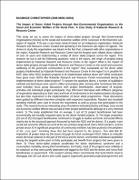| dc.description.abstract | BUSIINGE CHRISTOPHER (2008-M092-20054)
The Impact of Donor Aided Projects through Non-Governmental Organisations on the
Social and Economic Welfare of the Rural Poor: A Case Study of Kabarole Research &
Resource Centre
This study set out to assess the impact of donor-aided projects through Non-Governmental
Organisations (NGOs) on the social and economic welfare of the rural poor in the Rwenzori subregion
of Uganda. This was a case study research based on an indigenous organisation, Kabarole
Research and Resource Centre, located and operating in the Rwenzori sub-region of Uganda. The
choice to study this organisation was based on the fact that, compared with other organisations in
the region, Kabarole Research and Resource Centre had the longest work-related donor relations
of over 10 years and implementing a variety of donor aided projects across the region. This
research set out to ask the following questions: what is the nature, and origin of projects being
implemented by Kabarole Research and Resource Centre in the region? What is the impact of
donor aided projects through Kabarole Research and Resource Centre on the social and economic
wellbeing of the grassroots communities in the region? How sustainable are the donor aided
projects implemented by Kabarole Research and Resource Centre in the region? Is it possible for
KRC (also other NGO projects) projects to be implemented without donor aid? What constraints
have grass roots NGOs like Kabarole Research and Resource Centre encountered during the
implementation of donor-aided projects? To answer the questions above, a number of qualitative
methods and techniques were used to collect and analyse data. Among other techniques that were
used included; focus group discussions with project beneficiaries; observation of projects,
activities and individual project participants; Key Informant Interviews with different categories
of respondents depending on their roles and level of involvement in the implementation of projects
but also their experience in the implementation of donor aided programmes. These discussions
were guided by different interview schedules with respective respondents. Random and snowball
sampling methods were used to choose the respondents as well as groups that participated in the
study. This research found an interesting array of evidence indicating that by and large, some social
and economic welfare effects had accrued to their project beneficiaries although to a very minimal
extent. 1) The study established that on average, 5 out of 15 project beneficiaries had been
economically and socially impacted upon by the donor-funded projects. 2) The larger proportion
(10 out of 15) of project beneficiaries continued to struggle to realise economic and social effects
mainly due to the structural approach favoured by both the NGO and the donors. 3) Largely, more
social and economic effects occurred at the non-primary target level, that is NGO workers, and the
private sector.4) A significant proportion of community members had been pushed to the periphery
of the „very poor‟ including those that had been targeted by the projects. This was due to:
imposition of project ideas by the donors through the local counterpart NGO, failure to critically
assess the local contexts on the part of the NGO and the donors, and limited individual capabilities
among the targeted active poor to fully participate and benefit from projects that were given to
them. 5) These donor-aided projects accelerated the donor dependency syndrome and a
consumption mentality among their beneficiaries. 6) Finally, most of the projects were unlikely to
be sustained, as they were purely dependent and tagged to the NGO and the donors and not to their
beneficiaries or government. This research among others recommends that local NGOs need to
disengage and sort out donors that could support organically generated projects/programmes and
these programmes should be able to strengthen local entrepreneurship capacity and economic
tenacity.
Keywords: Non-Governmental Organisations, Donor aids, Rural poor, Social and economic
welfare | en_US |


